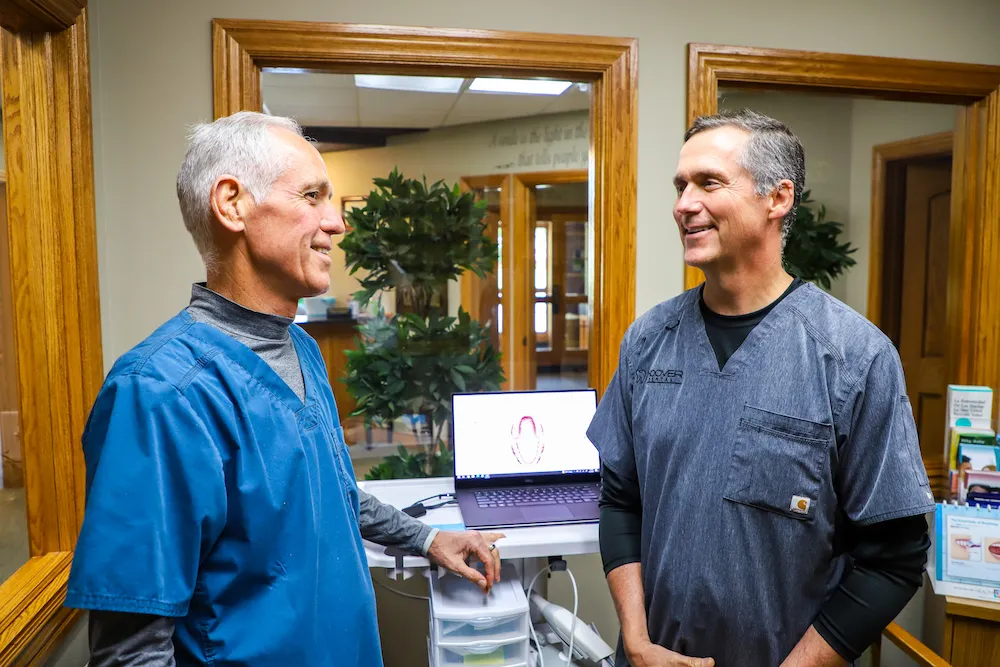If you live in Idaho Falls, dentures are a great way to improve your quality of life. The patients that choose to invest in dentures never regret their decision. If you’re considering dentures, our Idaho Falls team is here to answer any questions you have to help you with this process.
At Sunnyside Dental Center, we provide customized denture services to help meet the lifestyle needs of our patients. Because everyone is unique, we strive to create one-of-a-kind dentures that feel natural and provide a beautiful smile.
What to expect With Dentures
Dentures are natural-looking, removable replacement teeth. At Sunnyside Dental Center, we offer both full and partial dentures.
Full dentures are used when a patient’s natural teeth have all been removed. Once the gum tissue has healed, conventional full dentures are secured in place by hugging the contour of your jaw – creating a seal against your gums. They are removable for easy care and are adjusted to uniquely fit each patient.
If you aren’t missing all of your teeth, a partial denture can be used as an alternative to a bridge or multiple dental implants. These removable partial dentures clasp into place, supported by your existing teeth. This type of denture is generally considered as a removable alternative to a dental bridge or dental implants.

Frequently Asked Questions
The term “periodontal” means “around the tooth.” Healthy gum tissue fits snugly around each tooth, forming a slightly v-shaped crevice called a sulcus where the gum line meets the tooth. In healthy teeth, this space is typically three millimeters or less.
Periodontal diseases are infections that affect the tissues and bone supporting the teeth. As these tissues are damaged, the sulcus deepens into a pocket greater than three millimeters. Generally, the more severe the disease, the deeper the pocket and the greater the bone loss. Enlarged pockets allow harmful bacteria to thrive, making effective oral hygiene difficult. If left untreated, periodontal diseases can eventually lead to tooth loss. Additionally, periodontal disease has been recently linked to heart disease.
The mouth contains numerous bacteria. Periodontal disease starts when certain bacteria in plaque (the sticky, colorless film that constantly forms on teeth and surfaces lining the mouth) produce toxins and enzymes that irritate the gums and cause inflammation. This inflammation, which may be painless, can damage the attachment of the gums and bone to the tooth.
If plaque is not removed regularly, it can harden into rough, porous deposits called calculus or tartar. The tartar’s pores harbor bacteria and toxins, which cannot be removed with regular brushing. The only way to eliminate tartar is through professional cleaning at a dental office.
You should see your dentist for an evaluation if you notice any of the following symptoms:
- Gums that bleed easily
- Red, swollen, or tender gums
- Gums that have pulled away from your teeth
- Persistent bad breath
- Pus between the teeth and gums
- Loose or separating teeth
- A change in the way your teeth fit together when you bite
- A change in the fit of partial dentures
A bridge helps maintain the natural shape of your face and supports your lips and cheeks. Losing a back tooth can cause your mouth to sink and your face to look older. When a tooth is lost, nearby teeth may shift toward the empty space, placing unusual stress on the teeth and tissues in your mouth.
Additionally, the gum tissue and bone that hold teeth in place can deteriorate, increasing the risk of gum disease. Teeth that have tipped are difficult to clean, making them more prone to decay and, consequently, further tooth loss.
A fixed bridge is commonly cemented to the natural teeth adjacent to the missing tooth. A false tooth (pontic) replaces the lost tooth and is attached to the crowns.
While nothing can replace a healthy set of teeth, implants offer options for restoring your smile when disease or an accident results in tooth loss.
Implants are metal posts or frames surgically placed beneath your gums. After placement, they fuse to the bone of your jaw and act as artificial tooth roots. Replacement teeth, whether singular or grouped on a bridge or denture, are then mounted onto the implants.
Not all patients are candidates for implants. Candidates need healthy gums and adequate bone to support an implant and must be in overall good health.
It’s recommended to start regular dental visits for children around age 3. At this age, children can better communicate and understand instructions. However, if parents notice any concerns in their child’s mouth before age 3, they should bring the child in for an evaluation.
Start brushing your child’s teeth as soon as they appear. Do not give them a bottle with anything but water at bedtime or for naps.
A sealant is a plastic material applied to the chewing surfaces of the back teeth—premolars and molars. The plastic resin bonds into the depressions and grooves of these surfaces, acting as a barrier to protect enamel from plaque and acids. Sealants do not protect against decay between teeth; daily flossing and brushing 2-3 times a day are best for that.
As long as the sealant remains intact, the tooth surface will be protected from decay. Sealants hold up well under normal chewing and usually last several years before needing reapplication. During regular dental visits, your dentist will check and reapply sealants as necessary.
A crown is a restoration that covers, or caps, a tooth to restore it to its normal shape and size. Its purpose is to strengthen or improve the appearance of a tooth. A crown is placed for a number of reasons.
- to support a large filling when there is not enough tooth remaining
- to attach a bridge
- to protect weak teeth from fracturing
- to restore fractured or cracked teeth
- to cover badly shaped or discolored teeth
- to cover a dental implant
Several steps are involved in placing a traditional crown. Usually at least two visits are necessary. The dentist will prepare the tooth by removing the outer protion of your tooth to accommodate the thickness of the crown. If the tooth has a filling, part of the material may be left in place to serve as as foundation for the crown. An impression is made to provide and exact model of the prepared tooth. Your dentist or dental laboratory technician, following the written instruction of the dentist, will then make the crown from the model.
A crown is a restoration that covers or caps a tooth to restore its normal shape and size, strengthen it, or improve its appearance. Crowns are used for several reasons:
- To support a large filling when there is not enough tooth remaining
- To attach a bridge
- To protect weak teeth from fracturing
- To restore fractured or cracked teeth
- To cover badly shaped or discolored teeth
- To cover a dental implant
Placing a traditional crown usually involves at least two visits. The dentist prepares the tooth by removing the outer portion to accommodate the crown’s thickness. If the tooth has a filling, part of the material may be left as a foundation. An impression is made to provide an exact model of the prepared tooth. The dentist or dental laboratory technician then makes the crown from this model following the dentist’s instructions.
